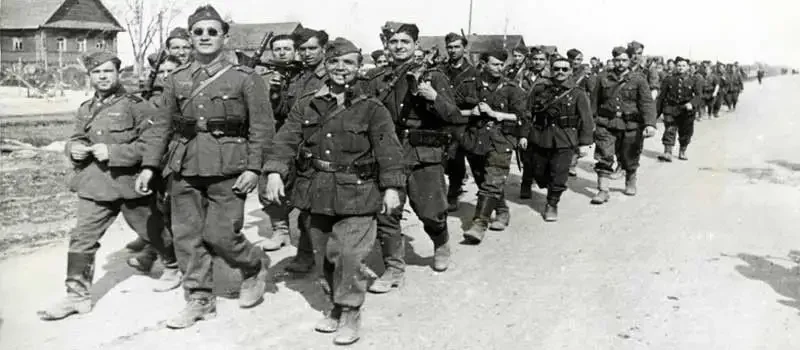- Military History
- Units & Divisions
- Spanish Units
- The Spanish Blue Division (1941-45)

The Spanish Blue Division (1941-45) Unit of Spanish soldiers that fought alongside German forces on the Eastern Front during World War II
The Blue Division was a unit of Spanish soldiers that fought alongside German forces on the Eastern Front during World War II. Between 1941 and 1945, the Soviet Union captured just over 300 Spaniards on the Eastern Front.
These anticommunist soldiers, serving in the German army and Waffen-SS, had volunteered to fight the Red Army to repay the Soviet Union for its attempts to export Communism during Spain's Civil War (1936-1939), when Soviet leader Josef Stalin provided weapons, pilots, training, and political guidance to the Spanish Communists.
At 16,000 strong, the Blue Division was the largest Spanish unit that fought along the Eastern Front during World War II. Incorporated into the German army, it defended positions near Novgorod and Leningrad from late 1941 to late 1943. It was followed in late 1943 by the Blue Legion, a unit of approximately 1,500, which was finally withdrawn under Allied pressure in March 1944.
From the withdrawal of the Blue Legion until the end of the war, several hundred Spaniards also served in the Waffen-SS, against the will of the Spanish government. During the war, 30 Spaniards deserted to the Soviet army, most of these while serving with the Blue Legion. Another 350 were captured; almost 100 during the Battle of Krasny Bor in February 1943.
Upon capture, Spanish prisoners of war were sent to camps throughout the USSR, often in small groups or together with Germans, Italians, Hungarians, and others. Because Spain was one of the most anticommunist nations in the world, and because Stalin identified the Franco regime as one that had defied him, the Spaniards were not treated humanely. Instead, many were tortured, denied basic essentials, or ordered to labor in dangerous conditions, including mining and forestry operations in the harsh Siberian climate. Many of the prisoners refused to serve as forced laborers, organizing strikes, fasts, and sabotage to avoid aiding the nation that was their persecutor.
After World War II, Spanish soldiers were not included in the repatriations that covered nations officially at war, instead remaining prisoners of the Soviets, even as Germans and Italians, were sent home. Spain and the Soviet Union did not establish diplomatic relations until the late 1960s, but indirect negotiations began through the offices of the International Committee of the Red Cross (ICRC) in 1949 to realize the return of the Spanish prisoners numbering just over 300.
With the intensification of the Cold War and the beginning of the Korean War, however, the Spanish government made little progress with its efforts. After the death of Stalin in March 1953, the Spanish government, with the continued help of the ICRC, continued its efforts, offering wheat and other commercial considerations indirectly to the USSR through Poland.
Finally, in early 1954, the Soviet leadership ordered the release of the remaining Spaniards in exchange for the extended Spanish economic concessions. On 2 April 1954, the 286 surviving Spanish POWs arrived at the port of Barcelona on the passenger ship Semiramis. Over 50 of the original prisoners had died in the Soviet Union as a direct or indirect result of mistreatment.
- Germany Nazi (1933-1945)
- Russia Soviet Union (1918-92)
- Spain
- {{#owner}}
- {{#url}} {{#avatarSrc}}
{{name}} {{/url}} {{^url}} {{#avatar}} {{& avatar}} {{/avatar}} {{name}} {{/url}} - {{/owner}} {{#created}}
- {{created}} {{/created}}























